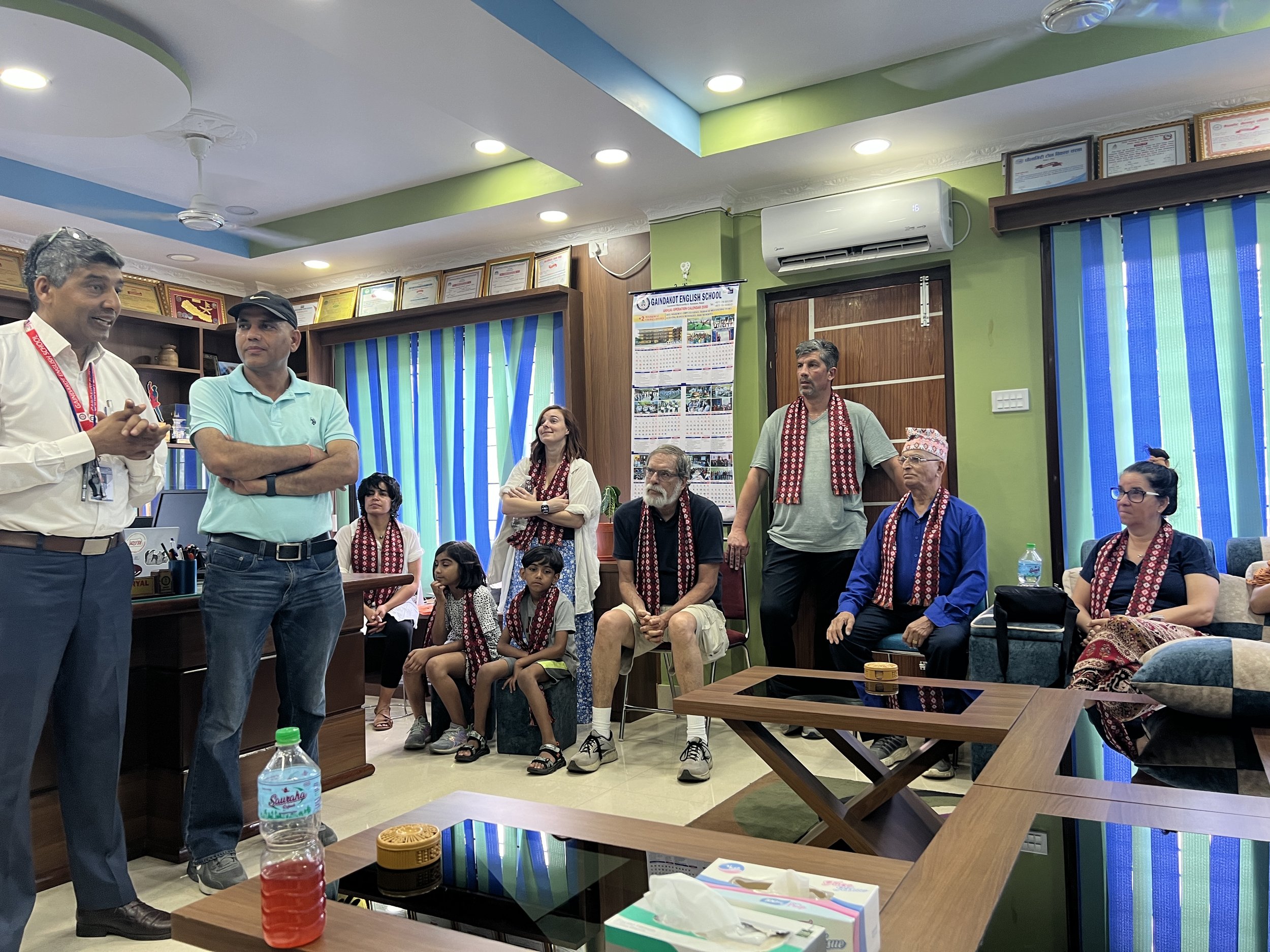Journey of Inspiration: Discovering the Beauty of Education in Nepal’s Gandakot English School
Describing the heat as simply “hot” would be an understatement considering the scorching 105-degree temperatures. It was a heat wave in a country accustomed to extreme climates, which had recently led to the closure of schools. I was one of 18 educators stepping off a bus, preparing for an arduous 8-hour trek to our destination in Butwal, Nepal.
I embarked on this journey to Nepal as a representative of MathKind, an organization dedicated to forging partnerships and offering support to global schools in improving their mathematics instruction. Undertaking such a goal from halfway across the globe, originating from the United States, is undoubtedly ambitious. Nevertheless, I find myself in the midst of Nepal, navigating through its terrain and braving the sweltering heat while traveling by bus. As our journey progresses, we have received a gracious invitation to visit a school en route.
This is not our initial school visit during this trip, and the warmth of the welcome remains consistent wherever we go. We are greeted with endearing gestures, such as “gifts of love” consisting of vibrant scarves, marigold necklaces, and seeds. These items symbolize well wishes and good fortune. Accompanied by our hosts, we are guided through classrooms and treated to a heartwarming traditional Thali meal. The genuine hospitality extended to us is universal throughout Nepal, yet each encounter leaves me profoundly humbled.
This particular school, Gandakot English School (GES), was established in 2062, and no, that’s not a typo. Nepal follows a distinct calendar system, currently recognizing the year 2080. GES is responsible for educating 1250 students, ranging from nursery to grade 12. The dedicated principal, Hiralal Aryal, tirelessly works to uphold the school’s mission. He shares with me, “I have devoted the last 9 years to this school, often sacrificing time with my own family.” His words resonate with deep pride. Mr. Aryal further explains, “We strive to create joyful and respectful experiences for our students throughout the day. Our core values encompass Discipline, Respect, Integrity, Pride, and Passion. Our objective is to nurture responsible global citizens, instilling in them a sense of love for social service. Rather than burdening our students with stressful content, we create a conducive environment where they can enjoy the learning process.”
As we walk together, Mr. Aryal points out a mural at the school’s entrance, proudly showcasing their mission.
“To develop our students to be good human beings by nurturing them to be responsible global citizens.”
And it is here, in this heat, in this small town that the tables turn, and I realize just how much I will learn from this journey.
Educators at GES are working to make their mission a reality. A mission which is devoted to creating good human beings resonates with utmost significance. The educators at GES wholeheartedly embrace the responsibility of shaping young minds and guiding their development. They understand that education extends beyond academic knowledge and seek to instill qualities that transcend the classroom walls. Their dedication to cultivating empathy, compassion, and integrity in their students is truly commendable, nurturing individuals who will contribute positively to their communities and the world.
The brightly colored mural at the entrance to the school contains more than the mission statement. Below are 7 principles that are displayed as a united circle of puzzle pieces:
Each of these statements holds profound significance, and delving deeper into them can offer valuable insights for schools aiming to serve their students effectively.
Let’s take a closer look at one statement in particular: “A resilient mind to handle uncertainty and volatility.”
In the aftermath of the pandemic, it is an opportune moment to prioritize the cultivation of resilience. But what does it truly mean to develop a resilient mind? What practical activities can be implemented to foster resilience? And more specifically, how can the discipline of mathematics contribute to this endeavor?
Building a resilient mind involves equipping individuals with the skills and mindset to navigate uncertain and volatile circumstances with adaptability and strength. To achieve this, schools can consider incorporating various activities into their curriculum. For instance, promoting problem-solving tasks that encourage students to face challenges, overcome obstacles, and persist in the face of adversity can foster resilience. Engaging in collaborative projects and group discussions can enhance students’ ability to work effectively with others, fostering adaptability and resilience in a social context.
Mathematics, in particular, offers unique opportunities to cultivate resilience. The subject inherently requires students to tackle complex problems, think critically, and develop logical reasoning skills. By engaging in mathematical problem solving and puzzles, students can develop perseverance, as they encounter setbacks and learn to approach problems from different angles. Encouraging students to reflect on their problem-solving strategies and learn from their mistakes can further enhance their resilience.
Furthermore, mathematics provides a platform for growth mindset development. Emphasizing that mistakes are a natural part of the learning process and encouraging students to view challenges as opportunities for growth can foster resilience. In mathematics, students can experience firsthand how setbacks and incorrect answers can lead to new insights and deeper understanding.
Incorporating real-life applications of mathematics, such as analyzing data and making predictions, can also contribute to building a resilient mind. By exploring the uncertainties and complexities of real-world scenarios, students develop the ability to handle ambiguity, adapt to changing circumstances, and make informed decisions — a crucial aspect of resilience in practical contexts.
The next part of the mural at GES are the goals — again striking in their beauty and clarity.
Let’s look more closely at this one: creating an environment that is conducive to learning.
In the context of the year 2023, what does it mean for a school to create an environment conducive to learning? What elements need to be present, and what changes should be considered? More specifically, let’s examine math classrooms and the vital question of accessibility for all students. Are we really ensuring that mathematics is accessible to every student, or do we unintentionally perpetuate a gatekeeper mentality through labeling and leveling practices?
In the year 2023, a school environment conducive to learning requires a shift in mindset and practices. It involves recognizing and valuing the unique strengths and learning styles of each student. It means moving away from rigid categorizations and labeling, such as referring to students as “low,” “strugglers,” or “high flyers.” Research has consistently shown that the simple act of not labeling students can have a significantly positive effect on their academic performance. Yet, despite this knowledge, the use of such labels persists in our discourse.
To create a truly inclusive and accessible mathematics classroom, it is essential to move beyond the gatekeeper mentality. Instead of focusing on categorizing students based on perceived ability, the emphasis should be on providing differentiated instruction and personalized support to meet individual needs. This can involve employing various instructional strategies, such as flexible grouping, differentiated assignments, and the use of diverse learning resources.
Furthermore, fostering an environment conducive to learning in mathematics requires promoting a growth mindset. Students should be encouraged to embrace challenges, view mistakes as opportunities for growth, and believe in their own potential to improve. By nurturing a growth mindset, teachers can inspire students to develop a positive attitude towards learning mathematics, free from the fear of judgment or failure.
Additionally, it is crucial to create a culture of inclusivity and respect within math classrooms. Teachers should foster a safe and supportive environment where students feel comfortable asking questions, expressing their ideas, and engaging in collaborative problem-solving. Celebrating the diversity of perspectives and contributions can empower students and foster a sense of belonging, promoting an environment that is truly conducive to learning.
In our current educational landscape, discussions in American schools often revolve around terms like acceleration, improvement, test scores, and data. Amidst this focus on academic achievements, there is a pressing need to intentionally prioritize social and emotional learning (SEL) and create space for the arts, play, and the pursuit of joy, creativity, and autonomy. It is crucial to envision a school that thoughtfully recognizes the significance of subjects like music and provides a purposeful education that extends beyond traditional academic domains.
At GES, I had the privilege of visiting their music room, where a poster proudly proclaimed the reasons why we learn music. This simple gesture speaks volumes about the school’s commitment to a well-rounded education.
Imagine a school where every subject is approached with such thoughtfulness and purpose. In this hypothetical school, education would be a holistic experience that encompasses not only academic growth but also the development of social and emotional skills, artistic expression, and physical well-being. Students would be encouraged to explore their passions and talents, fostering a sense of autonomy and agency in their own learning journeys.
In such a school, joy and creativity would be celebrated and nurtured. Music, art, and play would be given equal importance alongside core subjects, recognizing their inherent value in fostering imagination, self-expression, and emotional well-being. Students would have opportunities to engage in creative projects, collaborate with their peers, and unleash their unique abilities, igniting a lifelong love for learning and creativity.
Moreover, this purposeful education would extend beyond the classroom walls. Students would be encouraged to apply their knowledge and skills in real-world contexts, making meaningful connections to the world around them. They would develop a sense of social responsibility, understanding the power of their actions and the importance of contributing positively to their communities and the global society.
In envisioning an ideal educational landscape, it is vital to consider the role of the math classroom within this broader vision. The math classroom, too, can be transformed to align with the principles of purposeful education. It would be a space where mathematics is not merely seen as a subject to be conquered but as a dynamic and creative discipline that fosters critical thinking, problem-solving, and logical reasoning. Students would be encouraged to approach math with a growth mindset, embracing challenges and seeing mistakes as opportunities for growth. The math curriculum would go beyond rote memorization and formulaic procedures, emphasizing conceptual understanding and real-world applications. By infusing the math classroom with joy, curiosity, and a sense of wonder, students would develop a genuine appreciation for the beauty and utility of mathematics. In this transformative math classroom, all students would have access to equitable learning opportunities, ensuring that mathematics becomes an accessible and empowering domain for every learner.
The example set by GES challenges us to reimagine education, where values and vision are given due recognition and purpose. It beckons us to create a learning environment that fosters joy, creativity, and autonomy while valuing the social and emotional development of students. By embracing a holistic approach to education, we can empower students to become well-rounded individuals who not only excel academically but also find fulfillment, passion, and purpose in their lives. Schools can prioritize purposeful education, where every student can flourish and where the pursuit of knowledge is infused with joy, creativity, and the celebration of the human spirit.
And so, as I climbed back onto the bus, preparing for the long journey, I couldn’t help but reflect on how this school halfway around the globe was getting so much right. The experiences and insights gained during my time at GES lingered in my thoughts, resonating with profound significance. The dedication of the educators, the warm and inclusive environment, and the emphasis on holistic education left an indelible impression. As the wheels of the bus turned, so did my thoughts. I had all the time in the world to contemplate the lessons learned and the inspiration gained from this remarkable school.
Namaste,
Sue









